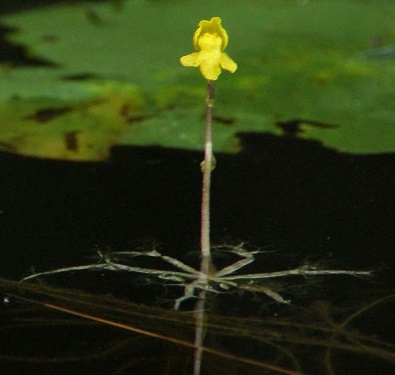 Water lilies are so romantic, aren’t they? The objects of paintings and poems. But out among them on dreamy ponds there lurks a seamy side of the pond: bladderworts. Dressed in deceptively pretty yellow flowers these plants spell trouble – for water fleas.
Water lilies are so romantic, aren’t they? The objects of paintings and poems. But out among them on dreamy ponds there lurks a seamy side of the pond: bladderworts. Dressed in deceptively pretty yellow flowers these plants spell trouble – for water fleas.
Bladderworts, Utricularia species, typically grow in open, acidic water where nutrients and CO2, an essential ingredient for photosynthesis, are in low concentrations. To supplement the low nutrients, the plants eat tiny aquatic animals: they’re carnivores. Bladderworts are the most diverse of the carnivorous plants, and twelve of the about 200 species world-wide are found in New England.
Our bladderworts typically have stalked, yellow, snapdragon-like flowers that are about the size of a quarter. The plants lack roots and are free-floating. One common species here, U., radiata, is distinctive for the radiating arms that sit on the surface of the water, keeping the plant upright. Bladderwort’s long branches extend downward into the water. Leaves form from the immersed stems and are finely dissected and fan-like, increasing their surface area and thus, enhancing the ability to absorb available nutrients.
Bladderworts take their name from the tiny dark – black or dark green -- bladders, or utricles, that form from the leaves. Take a bladderwort plant from the water you will see the little bladders looking like tiny grains in the long mass of stems and leaves. The bladders are highly specialized traps. Fine hairs at the opening of the bladders sense passing animals such as water fleas and, when triggered, cause the bladder to suddenly inflate, creating a vacuum and sucking the hapless animals in, closing the door behind them -- and all in less than a hundredth of a second. Digestive enzymes similar to papain, which helps break down meat fibers, make it a meal.
Bladderworts flower throughout most of the summer and die back in the fall. Lacking roots, they cannot be expected to survive the winter like other plants, but they develop dense masses, called turions, that include nearly fully formed leaves. These structures sink into muck at the bottom of the pond, and in spring the warming water causes the stem inside the turions to elongate and form a new plant.
Turions are heavy and not easily dispersed. Bladderworts can be dispersed by fragmentation, and U. inflata, native to southeastern states, has become invasive in Rhode Island, thought to have been introduced by humans. The plants do produce seeds. Bee pollinators are attracted by the yellow color of the flowers and nectar that is contained in a spur that projects forward from the flower. The flower is constructed so that bees can enter for the nectar and pollen but they cannot self-fertilize the flower.
A recent scientific study reported that the genome of one bladderwort has the smallest reliably sequenced plant genome. Despite the small size of the genome, it has more genes than well-known plants such as grape that has a much larger genome. Over the 10 to 20 million years that U. gibba has been around there has been considerable gene duplication and deletion. The genes that make up the genome have been pared down to essentially two sorts: those that define U. gibba as a plant, like genes for building cell walls, responding to light and producing flowers, and those that are essential for carnivory.
It is thought that carnivory was originally a defense mechanism to prevent predation by fungi and animals, much like caffeine protects coffee from herbivores. Bladderworts went a step further from prevention to predation. Evolution made of them stripped down killers, creating mayhem among our romantic waterlilies. Water fleas beware!
Story and photo by Gary Samuels
Gary Samuels is a retired plant pathologist who serves on PLC’s Board of Trustees, and chairs our Land Protection Committee. He and his wife Patty live in Deering.